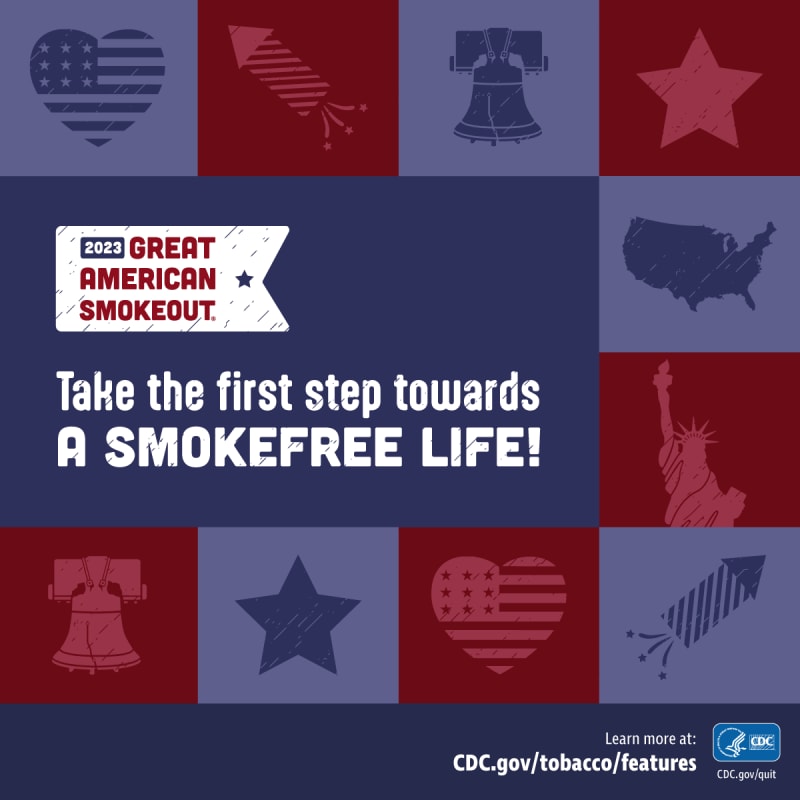The Great American Smokeout
Take the First Step Toward a Smokefree Life

Have you thought lately about quitting smoking? Quitting smoking is one of the best things you can do for your health.
You don’t have to stop smoking in one day. Start with day one. On November 16, join thousands of people across the country and start your quit-smoking journey with the American Cancer Society’s Great American Smokeout.
Quitting smoking can be hard, but you can increase your chances of success with a good plan and support. Counseling and medications can double or even triple your chances of quitting for good. There are many tools available to help you on your quit-smoking journey. Make quit-smoking support services a part of your plan.
Preparation is key to quitting successfully. Making a quit plan is the first step. Start today!
Most adults who smoke cigarettes want to quit. More than three out of five adults who have ever smoked cigarettes have quit.
Many people who smoke become addicted to nicotine, which is found in cigarettes and other tobacco products. This can make it hard to quit smoking. But the good news is there are proven treatments that can help you quit.
It’s never too late to quit smoking. Quitting smoking improves your health and reduces your risk of heart disease, cancer, lung disease, and other illnesses.

Both counseling and quit-smoking medicines approved by the FDA are proven to help people quit smoking. Using medicine and counseling together gives the best chance of quitting. There are also many support services that can help you on your quit-smoking journey:
- Quitlines provide free coaching—over the phone—to help you quit smoking. When you call 1-800-QUIT-NOW, you can speak confidentially with a highly trained quit coach. Quitlines are available throughout the United States, and coaching help is available in several languages. Some quitlines offer text messaging support.
- The National Texting Portal connects adults (18 years of age and older) in the United States with text message-based support to help them quit smoking. The text messages offer encouragement, advice, and tips for becoming smokefree and being healthier. The portal is available in English and in Spanish.
- The quitSTART App is a free smartphone app that uses tailored tips, inspiration, and quit challenges to help you quit smoking.
- Talking to your doctor or pharmacist can help you find which treatments or support services are right for you.
No matter your age or how long you’ve been smoking, quitting smoking improves health both immediately and over the long term.
It’s never too late to quit smoking. Quitting smoking improves your health and reduces your risk of heart disease, cancer, lung disease, and other smoking-related illnesses. While quitting earlier in life yields greater health benefits, quitting smoking is beneficial to health at any age.
Even people who have smoked for many years or have smoked heavily will benefit from quitting. Also, quitting smoking is the single best way to protect family members, coworkers, friends, and others from the health risks associated with breathing secondhand smoke.

James F. started smoking menthol cigarettes at age 14 to be like his father. He also knew other African American kids who smoked menthol cigarettes. Thirty years later, the damage from smoking started causing him health problems. Eventually, James decided to quit. He used nicotine patches and sugar-free gum to help him quit. Since he quit smoking, James has made other important changes to improve his health.
James has been smokefree for over two years. He says quitting was hard, but his health continues to be a big motivator. James became an avid cyclist, enjoys swimming, and exercises every morning.
James participates in the Tips From Former Smokers® campaign to send a message to people who think smoking isn’t going to hurt them just because they haven’t experienced a smoking-related health problem yet. He says if you smoke, you should quit.


